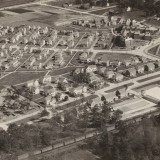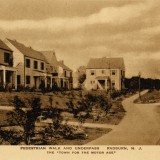Fair Lawn, Bergen County, New Jersey, USA
Promoted as the ‘town for the motor age’, Radburn was built upon ideas from Sunnyside Gardens. Billed as a ‘new’ town with the ‘first major innovation’ since the garden cities were first built. It was inspired directly by Letchworth, Hampstead and Welwyn as visited by its Architects. The community was intended to be a self-sufficient entity, with residential, commercial and industrial areas each supplementing the needs of others. The basic layout of the community introduced the "super-block" concept, cul-de-sac (cluster) grouping, interior parklands, and separation of vehicular and pedestrian traffic to promote safety. Every home was planned with access to park walks. The buildings were also designed with a focus on park areas, with living and sleeping rooms facing out towards these areas.
The creation of Radburn was massively effected by the 1929 stock market crash, with only one quarter of the full design being realised. The City Housing Corporation was declared bankrupt in 1934, leaving the town incomplete causing the surrounding lands to be sold off. It was named a National Historic Landmark in 2005.
Radburn has influenced town planning across North America and particularly the New Town Movement in post-war Britain.
Designed in 1928.
First residents moved in, in May 1929.
Building halted completely not long after the stock market crash in October 1929
Original master planner and any other critical master planning, design and architects
Clarence Stein and Henry Wright working with Alexander Bing’s City Housing Corporation
Architectural style/qualities:
Colonial Revival, Tudor Revival
Settlement size
Originally designed to cover 1,200 acres. Currently covers 149 acres
Population
Currently 3100 people - some 690 families. (Originally designed to house 25,000).
Housing/other built form densities
469 single family homes, 48 townhouses, 30 two family houses, a 93 unit apartment complex and 10 condominium units.
Governance arrangements
Radburn is part of the Borough of Fair Lawn. The Radburn Association, the corporate body provided for in the covenant, collects the charge, provides recreational programs, maintains the common property, enforces the covenants and sets policy. The Radburn Association is operated by a Board of Trustees composed of nine people and a manager-director. Trustees are nominated by Board members and elected by the residents of the community and the members of the Association.
The Citizens' Association is the civic group to which any resident may belong. It serves as a sounding board for public opinion, and through its president, who is automatically a member of the Board of Trustees during his term in office, provides the trustees with information on how residents view current issues, policies. (http://www.radburn.org/index.php/about)
Stewardship model:
All property within the boundaries of the Radburn Association is governed by The Declaration of Restrictions which runs with the land.
The Radburn Association is a private association which is empowered to administer Radburn's common properties and to collect from the owners of properties quarterly association fees to cover the Association's maintenance and operation of communal facilities.
Other notable features that reflect Garden City Principles:
A strong local jobs offer in the Garden City itself, with a variety of employment opportunities within easy commuting distance of homes –
Industrial estate of 127 acres
generous green space linked to the wider natural environment
18 acres of interior parks
strong local cultural, recreational and shopping facilities in walkable neighbourhoods
community center which houses administrative offices, library, gymnasium, clubroom and maintenance shops
strong vision, leadership and community engagement
Find out more:
The Radburn Association
http://www.radburn.org/
Also:
http://www.gutenberg.us/articles/radburn


